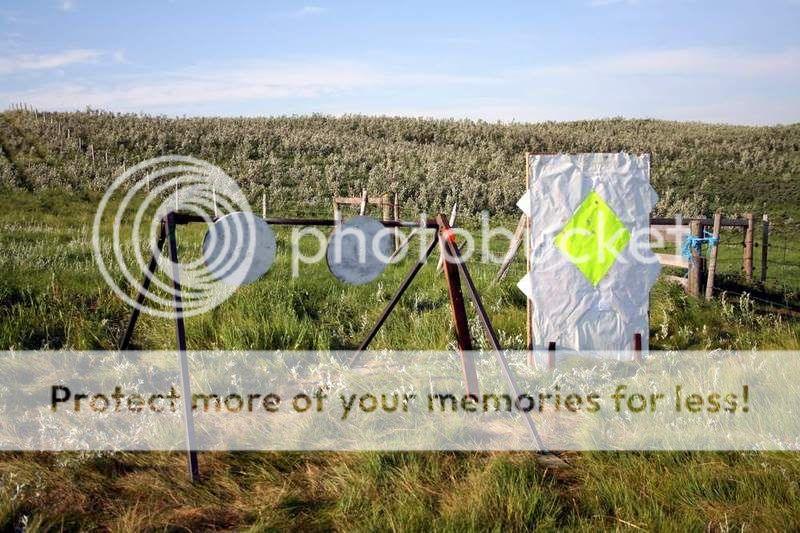When I shoot my 300 win. mag,at 3-400 yards at a target on the ground,if I miss,what will the bullet likely do?Will it tumble and lose velocity rapidly,or ricochet and go a long long way?I know there is no way to know for sure,I was just wondering for safety reasons.I am just wondering approximatly how far it would travel in that circumstance.
You are using an out of date browser. It may not display this or other websites correctly.
You should upgrade or use an alternative browser.
You should upgrade or use an alternative browser.
What happens to bullets when they hit the ground?
- Thread starter KQguy
- Start date
 Help Support Long Range Hunting Forum
Help Support Long Range Hunting Forum
AJ Peacock
Well-Known Member
It is dangerous enough that you should always have a backstop that is essentially 90 degrees to the line of fire, so the bullet will not ricochet. I'd never setup a target without a good backstop that will guarantee no ricochet.
AJ
AJ
300rum
Well-Known Member
When I shoot my 300 win. mag,at 3-400 yards at a target on the ground,if I miss,what will the bullet likely do?Will it tumble and lose velocity rapidly,or ricochet and go a long long way?I know there is no way to know for sure,I was just wondering for safety reasons.I am just wondering approximatly how far it would travel in that circumstance.
Almost all the situation the bullet will be stoped in the ground, UNLESS IS NOT HITTING A ROCK, METAL AND THEN WILL RICOCHET, ON 90 DEGREE.
iF YOU ARE DIGGING in the GROUND IN 1-4 INCHES DEEP YOU WILL FIND YOUR BULLEt.
Chris
RBrowning
Well-Known Member
I did a quick Google on rifle range safety zones and found this interesting article. I'm not sure where it is from.
http://www.saps.gov.za/crime_prevention/firearms/forms/sabsstd.pdf
It might give you an idea of what to watch for.
http://www.saps.gov.za/crime_prevention/firearms/forms/sabsstd.pdf
It might give you an idea of what to watch for.
long ranger
Well-Known Member
When I shoot my 300 win. mag,at 3-400 yards at a target on the ground,if I miss,what will the bullet likely do?Will it tumble and lose velocity rapidly,or ricochet and go a long long way?I know there is no way to know for sure,I was just wondering for safety reasons.I am just wondering approximatly how far it would travel in that circumstance.
There are many factors that will all change the end result.
Angle in which the bullet touchs the ground will dictate whether it will deflect back up off the ground and at what angle it does so.
Whether the ground is frozen or not also plays a big role. Ground that has been tilled or broken up is less likely to cause ricochets.
Type of bullets also play a big part. Light thin jacketed varmit bullets tend to come apart easily when the touch anything, heavy jacketed or bonded hunting bullets take much more to expend their energy.
Velocity also play a big part and can make things very hard to predict. I find I get more ricochets with 22LR than my bigger calibers. FMJs or machined steel core bullets are probably the worst. I find steel cores from my 50s and 20mm scattered all over the fields, usually quite a long way away from where we have the targets set up.
This is my range, the hill behind is elevated another 90 feet above where my bullets strike the ground, when shooting at the paper target. We have found many places where bullets have picked up off the ground and gone into the wild blue yonder. The gongs are angled so as to deflect the bullets directly into the ground

This is what the gongs and target look like at 750 yards away. You will notice I shoot at a downward angle and have a 6 mile track of empty fields for the bullets to land in.
I am hoping to get a bobcat in to cut a 90 degree backstop in the spring.

The further ridge is 1600 yards out and I move the targets out there for real long range fun.
Last edited:
Boy what a thorny question.
The link posted is pretty accurate though. There was a study commissioned by the PA legistlature on this very subject due to reports of bullets hitting houses. Their study focused on muzzle loaders and shotguns primarily compared to the 30 06 with a 150 SP (exposed lead tip). It is on the PA legislative site now, I will try to find the link. Mountain Top technologies was the sub contractor for the Army who did the study for the legislature.
This study mirrors the original army findings and range rules almost perfectly. If the bullet hits the ground at an angle between 10 and 35 degrees it will often/normally not deflect if the ground is relatively soft and free of hard objects. However most firing is done at angles less than 10 degrees and when that is the case the bullets will/can deflect and skipped an additional 1700 plus meters regardless of the ground surface. It is not aperfectly linear skip too on the original target line and they routinely deflect at 90 degree or greater angles off the target line. They can deflect up to 1800 meters in the air.
In this recent PA study the muzzle loaders and shotguns with plastic tip SST type sabot bullets skipped to the same distance of the lead tip 30 06. The study attributed this to the exposed lead tip and thin jacket deforming and slowing things down on the 30 06 and the plastic tip and hard jacket reinforcing the SSTs and preventing deformation which would slow the bullets down.
The other military studies are based off the FMJ bullets which in reality are only copper jacket bullets with the open part of the jacket at the base instead of the point. They are designed to fragment at the cannelure(deliberately on hitting tissue) in many cases and others are designed for max penetration. And No that is not against the Geneva Convention either. The Armor Piercing bullets normally have a tungten or similar type insert inside the copper jacketed bullet that is the actual penetrator.
The harder/thicker jacket and plastic tips, the more the bullet will retain original shape and velocity vs the lead tips and highly deformed thinner jacket bullets.
Bottom line is know what is beyond your target, try to have a soft ground backstop and at an angle of greater than 10 degrees to your shooting target line in a perfect world If it is rocky, expect ricochets at almost any angle.
BH
The link posted is pretty accurate though. There was a study commissioned by the PA legistlature on this very subject due to reports of bullets hitting houses. Their study focused on muzzle loaders and shotguns primarily compared to the 30 06 with a 150 SP (exposed lead tip). It is on the PA legislative site now, I will try to find the link. Mountain Top technologies was the sub contractor for the Army who did the study for the legislature.
This study mirrors the original army findings and range rules almost perfectly. If the bullet hits the ground at an angle between 10 and 35 degrees it will often/normally not deflect if the ground is relatively soft and free of hard objects. However most firing is done at angles less than 10 degrees and when that is the case the bullets will/can deflect and skipped an additional 1700 plus meters regardless of the ground surface. It is not aperfectly linear skip too on the original target line and they routinely deflect at 90 degree or greater angles off the target line. They can deflect up to 1800 meters in the air.
In this recent PA study the muzzle loaders and shotguns with plastic tip SST type sabot bullets skipped to the same distance of the lead tip 30 06. The study attributed this to the exposed lead tip and thin jacket deforming and slowing things down on the 30 06 and the plastic tip and hard jacket reinforcing the SSTs and preventing deformation which would slow the bullets down.
The other military studies are based off the FMJ bullets which in reality are only copper jacket bullets with the open part of the jacket at the base instead of the point. They are designed to fragment at the cannelure(deliberately on hitting tissue) in many cases and others are designed for max penetration. And No that is not against the Geneva Convention either. The Armor Piercing bullets normally have a tungten or similar type insert inside the copper jacketed bullet that is the actual penetrator.
The harder/thicker jacket and plastic tips, the more the bullet will retain original shape and velocity vs the lead tips and highly deformed thinner jacket bullets.
Bottom line is know what is beyond your target, try to have a soft ground backstop and at an angle of greater than 10 degrees to your shooting target line in a perfect world If it is rocky, expect ricochets at almost any angle.
BH
CRNA
Well-Known Member
Hello all, this is my first post. I just wanted to put my .02 in. I have shot in my parent's back yard/woods since I was a child. I had noticed several years ago that something "bounced" off of a tree that was behind my target. I was shooting a 9mm handgun. I assumed that the bullets were just going into the ground, but I found out very differently once I started examining the trees downrange. The trees were litteraly speckeled with bullet holes. Some fresh, some very old.
I agree that the angle of the shot has alot to do with it. Also, the ammo that I target practice in my 9mm are FMJs. These, I have found, do richochet quite a bit more than soft-nosed or hollow-point bullets.
After this revelation I have been much much more cognizant of what is downrange of my target. Even if my bullet contacts "soft dirt".
I agree that the angle of the shot has alot to do with it. Also, the ammo that I target practice in my 9mm are FMJs. These, I have found, do richochet quite a bit more than soft-nosed or hollow-point bullets.
After this revelation I have been much much more cognizant of what is downrange of my target. Even if my bullet contacts "soft dirt".
Similar threads
- Replies
- 92
- Views
- 9K
- Replies
- 4
- Views
- 2K